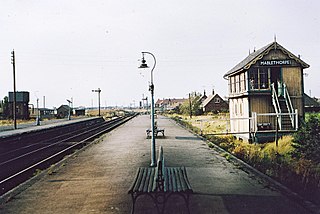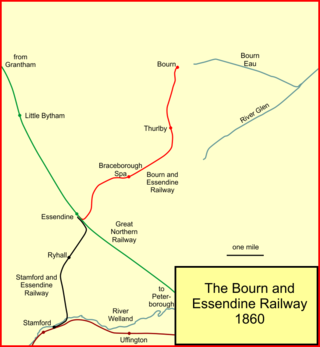
The Great Northern Railway (GNR) was a British railway company incorporated in 1846 with the object of building a line from London to York. It quickly saw that seizing control of territory was key to development, and it acquired, or took leases of, many local railways, whether actually built or not. In so doing, it overextended itself financially.

Billingborough is a village and civil parish in the South Kesteven district of Lincolnshire, England. It is situated approximately 10 miles (16 km) north of Bourne and 10 miles south of Sleaford, and on the B1177 between Horbling and Pointon just south of the A52.
The Derbyshire and Staffordshire extension of the Great Northern Railway was an English railway network built by the GNR to get access to coal resources in the area to the north and west of Nottingham. The Midland Railway had obstructed the GNR in its attempts to secure a share of the lucrative business of transporting coal from the area, and in frustration the GNR built the line. The line was forked: it reached Pinxton in 1875 and a junction with the North Staffordshire Railway at Egginton, approaching Burton on Trent in 1878. The line cut through Derby, resulting in considerable demolition of housing there.
The Great Northern and Great Eastern Joint Railway, colloquially referred to as "the Joint Line" was a railway line connecting Doncaster and Lincoln with March and Huntingdon in the eastern counties of England. It was owned jointly by the Great Northern Railway (GNR) and the Great Eastern Railway (GER). It was formed by transferring certain route sections from the parent companies, and by the construction of a new route between Spalding and Lincoln, and a number of short spurs and connections. It was controlled by a Joint Committee, and the owning companies operated their own trains with their own rolling stock. The Joint Line amounted to nearly 123 miles (198 km) of route.

Horbling is a village and civil parish in the South Kesteven district of Lincolnshire, England. It lies on the B1177, 7 miles (11 km) south-east of Sleaford, 15 miles (24 km) north-east of Grantham and 1 mile (1.6 km) north of Billingborough.

Rippingale is a village and civil parish in the South Kesteven district of Lincolnshire, England. The population of the civil parish was 929 at the 2011 census. The village is situated on the A15 road, about 5 miles (8 km) north from Bourne.

Bourne was a railway station serving the town of Bourne in Lincolnshire, which opened in 1860 and closed to passengers in 1959.

Morton Road railway station was a station serving the village of Morton, Lincolnshire on the Great Northern Railway Bourne and Sleaford railway. It opened in 1872 and closed to passengers in 1930. The section from Bourne through Morton to Billingborough remained open for goods until 1965.

Rippingale railway station was a station serving the villages of Rippingale, Dowsby and Dunsby, Lincolnshire on the Great Northern Railway Bourne and Sleaford railway. It opened in 1872 and closed to passengers in 1930. The section from Bourne through Rippingale to Billingborough remained open for goods until 1964.

Billingborough and Horbling railway station was a station serving the villages of Billingborough, Horbling and Threekingham, Lincolnshire on the Great Northern Railway Bourne and Sleaford railway. It opened in 1872 and closed to passengers in 1930. The section from Bourne to Billingborough remained open for goods until 1964.

Aswarby and Scredington railway station was a station close to Scredington, Lincolnshire on the Great Northern Railway Bourne and Sleaford railway. It opened in 1872 and closed in 1930. It was originally shown on maps as Aswarby Station, but by 1905 it was shown as Aswarby and Scredington Station.

The East Lincolnshire Railway was a main line railway linking the towns of Boston, Alford, Louth and Grimsby in Lincolnshire, England. It opened in 1848. The ELR Company had leased the line to the Great Northern Railway, and it was the latter which constructed the line and operated it, as its East Lincolnshire Line.

The Louth to Bardney Line was an English railway line built by the Louth and Lincoln Railway Company, in Lincolnshire, England. It opened in stages between 1874 and 1876, after serious difficulties in raising subscription capital, and following alteration to the planned route. It was hoped to serve large reserves of ironstone along its route, but the deposits were not as large as hoped, and the line was never financially successful.

The Nottingham Suburban Railway was a British railway company that constructed a line 3.65 miles (5.87 km) in length serving the north-eastern suburbs of Nottingham. It was built to shorten the distance by train to Ilkeston and towns on the Leen Valley railway line, and to connect important brickworks near Nottingham. The short line was expensive to build due to difficult topography; it opened in December 1889, and was worked by the Great Northern Railway; the trains used that company's Nottingham terminus.
The Stamford and Essendine Railway was built to connect Stamford, Lincolnshire, in England, to the nearby Great Northern Railway. It was a short line, and it opened in 1856. It was not commercially successful, and the directors sought a means of connecting Stamford directly to Peterborough. This was the Sibson Extension, opened from Stamford to Wansford in 1867, but the junction there did not facilitate through running to Peterborough, and the Sibson Extension was even less successful than the first line. It was closed in 1929.
The Boston, Sleaford and Midland Counties Railway opened a railway line between Grantham and Boston, through Sleaford, England. It opened in two stages, in 1857 and 1859.

The Mablethorpe Loop railway was formed in Lincolnshire, England, by two independent railway companies, which built branches from the East Lincolnshire Line.
The Grantham and Lincoln railway line was a line in Lincolnshire, built by the Great Northern Railway to shorten the distance between the town of Grantham and city of Lincoln. It had already formed a network in Lincolnshire, but the route from London and points south and west of Grantham was very indirect.

The Bourn and Essendine Railway was a seven mile long branch line which connected Bourne in Lincolnshire to the East Coast Main Line in the village of Essendine in Rutland. The line was opened in 1860; it was a single line and served the town of Bourne and the villages of Thurlby, Braceborough and Essendine. Its line ran through the ceremonial counties of Lincolnshire and Rutland in the East Midlands of England.
The Lincolnshire lines of the Great Northern Railway are the railways, past and present, in the English county built or operated by the Great Northern Railway.

















